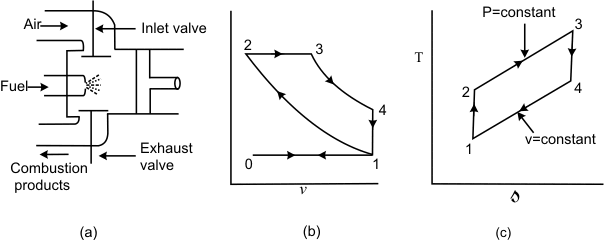AIR STANDARD DIESEL CYCLE

Figure 29.3 (a), (b) and (c) |
The Diesel cycle was developed by Rudolf Diesel in Germany. Figures 29.3 (a), (b) and (c) explain the working principle of an Air Standard Diesel cycle. The following are the processes.
0-1: Constant pressure suction during which fresh air is drawn into the cylinder as the piston executes the outward motion.
1-2: The air is compressed isentropically. Usually the compression ratio in the Diesel cycle is much higher them that of Otto cycle. Because of the high compression ratio, the temperature of the gas at the end of isentropic compression is so high that when fuel is injected, it gets ignited immediately.
2-3: The fuel is injected into the hot compressed air at state 2 and the fuel undergoes a chemical reaction. The combustion of Diesel oil in air is not as spontaneous as the combustion of gasoline and the combustion is relatively slow. Hence the piston starts moving outward as combustion take place. The combustion processes is conveniently approximated as a constant pressure energy addition process.
3-4: The combustion products undergo isentropic expansion and the piston executes an outward motion.
4-1: The combustion products are exhausted at constant volume when the discharge port opens. This is replaced by a constant-volume energy rejection process .
1-0: The remaining combustion products are exhausted at constant pressure by the inward motion of the piston.
In the analysis of a Diesel cycle, two important parameters are: compression ratio  and the cut-off ratio and the cut-off ratio  . The cut-off ratio is defined as the ratio of the volume at the end of constant-pressure energy addition process to the volume at the beginning of the energy addition process. . The cut-off ratio is defined as the ratio of the volume at the end of constant-pressure energy addition process to the volume at the beginning of the energy addition process.
 |
(29.17) |
Energy added  |
(29.18) |
Energy rejected  |
(29.19) |
 |
(29.20) |
or
 |
(29.21) |
1-2 is Isentropic:
4-1 is Constant volume:
But 
Hence
Since 1−2 and 3−4 are isentropic processes 
 and and  |
|
Hence
 |
(29.22) |
 |
(29.23) |
Also to be noted
 |
(29.24) |
The compression ratios normally in the Diesel engines vary between 14 and 17.
|